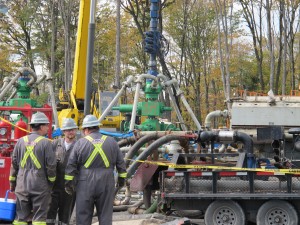Report faults EPA for failing to regulate fracking with diesel
A new report out today reveals natural gas drillers could be using diesel to frack wells without the mandated federal permits. Unlike other chemicals used in gas drilling, Congress requires extensive oversight if diesel is present.
The so-called Halliburton Loophole in the Energy Policy Act of 2005 exempts chemicals used in hydraulic fracturing from federal oversight. But diesel is an exception. That’s because it moves quickly through water, and even small amounts of the neurotoxins within the liquid fuel cause liver and kidney damage.
But a public records request to the Environmental Protection Agency by the nonprofit Environmental Integrity Project shows no permit applications or approvals to frack with diesel. This despite the group’s finding that since 2010, 33 separate companies publicly reported a total of 351 wells fracked with diesel in 12 states. Mary Green is the group’s senior attorney.
“It seems that EPA was convinced this problem was largely if not completely eliminated,” Green told StateImpact.
A back and forth between the EPA and industry over fracking with diesel began back in 2011 when House Democrats, led by California Congressman Henry Waxman, sent a letter to the EPA with evidence that companies continued to use diesel to frack without obtaining the required permits under the Safe Drinking Water Act.
As far back as May, 2011, the EPA reached out to industry, seeking input on how to implement the Safe Drinking Water Act when companies fracked with diesel. The agency released draft guidance in May 2012. And this February, it issued its final guidance on permitting wells fracked with diesel.
To frack with diesel, companies would have to undergo an extensive review and public comment process, similar to what is required when operators seek to drill a waste disposal well. So it’s not surprising that the use of diesel in fracking has dropped since 2011. But the Environmental Integrity Project’s report shows 24 wells have used diesel since the new guidelines were issued. And yet EPA has not issued any permits under the Safe Drinking Water Act for these wells. None of those wells are in Pennsylvania.
But the report confirmed that dating back to 2011, 25 wells in Pennsylvania used kerosene, a liquid hydrocarbon fuel similar to diesel in both usefulness to drillers, and toxicity. (Kerosene is also referred to as Navy fuel or marine diesel). The EPA’s current guidelines, issued in February, require a permit for the use of kerosene, along with four other types of diesel fuel. These fuels contain the highly toxic BTEX, or benzene, toluene, ethylbenzene and xylene compounds. The guidelines describe the health risks as follows:
-
An increase in anemia or a decrease in blood platelets from benzene exposure; An increased risk of cancer from benzene exposure; Problems with the nervous system, kidneys or liver from toluene exposure; Problems with the liver or kidneys from ethylbenzene exposure; and Damage to the nervous system from exposure to xylene.
Several industry representatives told StateImpact that the use of kerosene preceded the EPA’s final guidance, and therefore, did not require a permit. But Mary Green from the Environmental Integrity Project insists that even before the final guidance was issued, drillers should have sought a permit and the EPA should have enforced the SDWA. The language in the 2005 Energy Policy Act simply refers to “diesel” fuel. And questions to the EPA did not get a direct response. Instead, the agency issued this statement to reporters:
EPA is currently reviewing the report released from the Environmental Integrity Project on the use of diesel in hydrofracking operations. As part of EPA’s efforts to provide clarity on the permitting requirements applicable to the use of diesel in hydraulic fracturing, EPA released an interpretive memorandum and technical guidance in February 2014. During the development of these documents, EPA actively engaged with companies that used diesel in their operations to inform them that they would be required to obtain a permit if they continued to use diesel in their operations. Many of those companies indicated that they planned to discontinue the use of diesel in their operations. EPA believes that since the release of the interpretive memorandum and technical guidance many companies have followed through on those plans and no longer use diesel in their hydrofracking operations.
In February 2014, EPA released an interpretive memorandum and a technical guidance related to the use of diesel in hydraulic fracturing. The interpretive memo clarifies Class II permitting requirements for underground injection of diesel fuels in hydraulic fracturing practices. The technical guidance provides recommendations for EPA permit writers to consider when implementing permitting requirements. This guidance does not limit or supersede state authority of oil and gas permitting activities.
EPA defined the term “diesel fuels” in the memorandum to enable implementation of the Underground Injection Control program under the Safe Drinking Water Act and to alleviate uncertainty about the statutory term. The five fuels listed below were found to fall under the definition of “diesel fuels” and are currently used in a small percentage of wells.
Unlike the other 11 states referred to in the report, Pennsylvania authorities do not administer the section of the Safe Drinking Water Act that regulates underground injection wells, instead the law is enforced by the EPA.

















